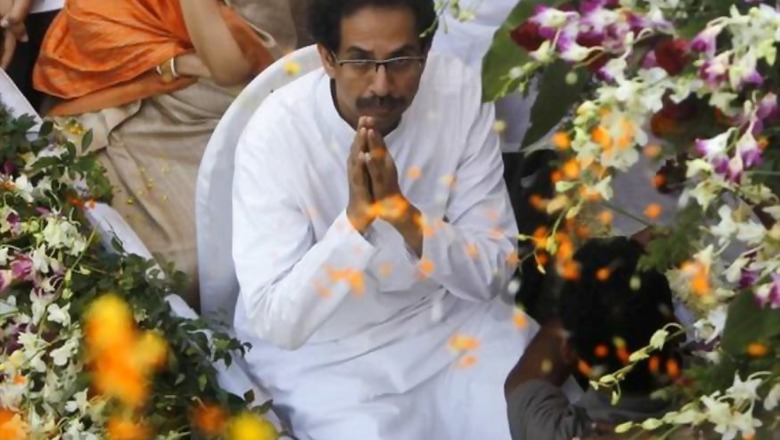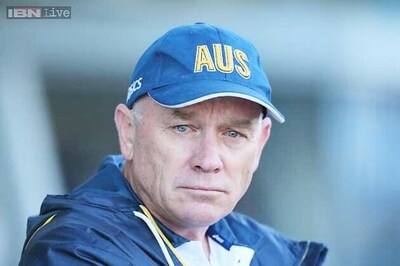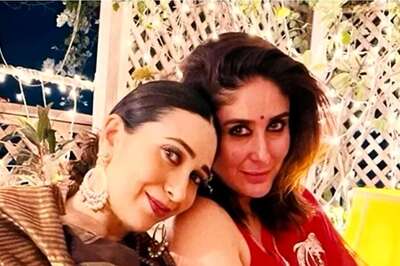
views
Scenario 1: Former Congress president Rahul Gandhi mocks Hindutva icon ‘Swatantryaveer’ Vinayak Damodar Savarkar and draws fire from Shiv Sena leader and Rajya Sabha MP Sanjay Raut. Raut tweeted: “We respect Pandit Nehru and Mahatma Gandhi, you don’t insult Savarkar. Samajhne wale samajh gayen hai... Jai Hind!!”
Savarkar’s grandson Ranjit reminds Shiv Sena president and Maharashtra Chief Minister Uddhav Thackeray of his statement earlier this year, wherein he said those criticising the Hindu nationalist must be “beaten with shoes”. In 2004, similar disrespect to Savarkar — who is a polarising, complex, yet revered figure in sections of Maharashtrians — by Congress leader and then petroleum minister Mani Shankar Aiyar saw protests by Sainiks, with late Bal Thackeray even hitting Aiyar's effigy with shoes.
Scenario 2: The Shiv Sena supports the contentious Citizenship Amendment Bill in the Lok Sabha, prompting protests from the Congress. Senior Congress leaders claim the miffed party may even walk out of the Uddhav Thackeray-led government in Maharashtra, of which it is part with Nationalist Congress Party (NCP). A chastised Shiv Sena is forced to initiate damage control, walking out in the Rajya Sabha and abstaining when the bill was put to vote, claiming concerns raised by the party had not been addressed adequately by the Narendra Modi government.
“Shitavarun bhatachi pariksha” (test a grain from a pot of rice to see if it has been cooked) is a popular Marathi saying. As these controversies and clashes indicate, the Shiv Sena's coalition with the Congress and NCP may witness such rough weather on ideological and political differences, especially on the issue of Hindutva and nationalism.
The reasons are obvious. When it comes to an ideology and agenda, the Congress and Sena are at opposite ends of the political spectrum, with the NCP somewhere in between. The sole glue for these three parties is the need for power in Maharashtra, the country’s most urbanised and industrialised state, and the political expediency of keeping the BJP away.
While the BJP is eager to exploit the situation to the hilt, the Shiv Sena will have to ensure that its biggest gamble of striking an alliance with its erstwhile foes does not come a cropper. The Congress too has a lot at stake at a pan-India level. For instance, Bahujan Samaj Party (BSP) president Mayawati has questioned the “double-standards” of the Congress being part of a government with the Shiv Sena despite the ideological dissonance.
Though the Shiv Sena is seen as a pro-Hindutva party, it is essential to note that its relationship with the idea of Hindutva, like many of its positions during its 53-year old existence, was born out of political expediency and opportunism.
The Shiv Sena was founded in 1966 as an organisation upholding the causes of the sons-of-soil, namely the ‘Marathi manoos’. Maharashtrians felt that despite getting their own linguistic state of Maharashtra, they lacked primacy in their own capital, Mumbai, where they were and continue to be the largest minority and not the majority.
The launch of the organisation was the culmination of a campaign launched by Shiv Sena supremo, late Bal Thackeray, through his cartoon weekly ‘Marmik’ and a result of the social, political and economic process in 1960s Maharashtra. Essentially, the Shiv Sena was a child of its times.
Unlike the BJP, Sangh Parivar and its affiliates, for whom Hindutva is second skin, the Shiv Sena did not have Hindutva as its central canon. It formally adopted Hindutva in the late 1980s in response to the rising tide of majoritarian assertion across the country after incidents like the Shah Bano case and the subsequent watering down of the Supreme Court's landmark judgment by the Rajiv Gandhi government and the Ram Mandir agitation.
In 1987, the Shiv Sena chief openly solicited votes on Hindutva in the by-elections to the Vile Parle assembly seat in Mumbai, which the party's Dr Ramesh Prabhoo won. Incidentally, his opponent, the Janata Party's Pranlal Vora, was supported by the BJP.
Though the Sena asserted its Hindu identity even earlier through protests at disputed religious sites such as Durgadi, Mahikavati and Haji Malang, anti-Muslim rhetoric through 'Marmik' and communal riots, the Vile Parle bypoll was a defining moment. This, and its success in the civic polls in communally-polarised Aurangabad in Marathwada, marked its shift to aggressive Hindutva in the state that birthed the ideology.
The use of Hindutva as a marker of identity helped the Shiv Sena expand in regions beyond its traditional Mumbai-Thane belt like in Marathwada, which was once under the suzerainty of the Nizam of Hyderabad. In this area, the atrocities of the Razakars, a fundamentalist militia that wanted to prevent the integration of the state into India, remain embedded in popular memory. The slogan “Khan hava ki baan hava?” (Do you want the Khan or the bow-and-arrow — Shiv Sena's symbol?) is in vogue even today.
More importantly, the projection of the Sena as the upholder of a larger Hindu identity also helped the party expand into the growing non-Maharashtrian communities in Mumbai, create an auxiliary constituency, and forge an alliance with the BJP in 1989. The 1992-93 riots in Mumbai, and the Shiv Sena's role in it, revealed how the othering of the Muslims had helped the Sena consolidate and marshall its forces, especially among the rough-and-ready lower and lower-middle class Maharashtrians. Similarly, the clashes in the 1970s and 1980s with Buddhist Dalits, the followers of Dr Babasaheb Ambedkar who were seen as challengers to the Hindu faith, brought it close to other Dalit castes who resented the dominance of the former in the Dalit movement.
However, the transition from a nativist, mono-lingual agenda to Hindutva came at a price. This meant that the party and its cadre had to turn a blind eye towards assertion by other social and linguistic groups like north Indians, Gujaratis and Marwadis in a fast-evolving, de-industrialised Mumbai. The city's shift to the service sector after the textile mills and engineering industries, which largely employed Marathi labour, saw the Maharashtrians compete with Hindi-speaking migrants in vocations like hawking and contract labour where the latter had an economic advantage.
However, to the Shiv Sena's credit, the party has a wide social base, even in section of Marathi-speaking Muslims, due to its strong grassroots network.
The dissonance between the Marathi identity and a larger agenda based on Hindutva, which stood the risk of isolating the Sena's core vote base, was manifested when the Maharashtra Navnirman Sena (MNS) led by Uddhav’s estranged cousin Raj walked away with a chunk of Maharashtrian votes in the 2009 Lok Sabha and assembly polls.
After a point, Hindutva has been a self-defeating plank for the Shiv Sena, inhibiting its rise as a pan-Maharashtra regional force by estranging sections like Buddhist Dalits and Maharashtrian Muslims and making them more inward looking. This is a distinguishing feature between the Sena and other regional parties, especially those in south India, which are based on an ethnocentric, sub-national agenda.
Though the MNS is a politically depleted force today, the Shiv Sena has realised it has to walk on eggshells even as it does the inevitable — reaching out to non-Maharashtrians to expand its electoral catchment, for which a mix of Hindutva and aspirational agendas like development will serve as a catalyst.
The Savarkar row makes it clear that the Shiv Sena-led alliance government is walking a minefield on these “sensitive issues”, which can be exploited by disgruntled leaders in all parties who feel left out of the power matrix.
As the dissonance between the Congress and Shiv Sena on these issues reveals, the BJP will spare no opportunity to catch the fledgling alliance in a bind to pull it down under the weight of its own contradictions. The BJP will look at exploiting any cracks on these issues, to convert them into fissures, and later, tectonic shifts.
It will be interesting to watch the Shiv Sena's reaction (and also that of the Congress and NCP) if one of its long-standing demands — the Bharat Ratna for Savarkar — is fulfilled. While Congress and NCP leaders rail against the implementation of the National Register of Citizens (NRC) and the Citizenship Amendment Act (CAA) in Maharashtra, it was the Shiv Sena that had earlier sought a nationwide NRC exercise. The Sena has always sought that illegal Bangladeshi migrants to Mumbai and neighbouring areas be identified and deported, with the erstwhile Shiv Sena-BJP government that ruled Maharashtra from 1995-1999 launching a short-lived crackdown.
Activities of fringe Hindutva groups like the Shivaprathisthan Hindustan led by Sambhajirao Bhide ‘Guruji’, who has been accused of involvement in the Bhima-Koregaon violence, religion-based quotas for Muslims and demands for a ban on the controversial Sanatan Sanstha are other potential stress-points in the Shiv Sena's relationship with the Congress and NCP.
The BJP has repealed Article 370, which conferred special status on Jammu and Kashmir, banned one-sided Triple Talaq and cleared the decks for a Ram Temple at Ayodhya. A uniform civil code, which is part of the common agenda of both the Shiv Sena and the BJP, will mark the culmination of the Hindutva project, at least for now.
Hence, the Shiv Sena cannot be seen as diluting its position on these points, while also taking care against upsetting the applecart in Maharashtra. It is this deft act, requiring the grace and composure of a ballerina, which will test the mettle of the party and Uddhav and prove crucial to their future.
(The author is a journalist and author of the book ‘The Cousins Thackeray: Uddhav, Raj and the shadow of their Senas’ published by Penguin Ebury Press. This is the first political biography of Uddhav and Raj Thackeray, and has been translated into Marathi as ‘Thackeray Viruddha Thackeray’. Views are personal)




















Comments
0 comment